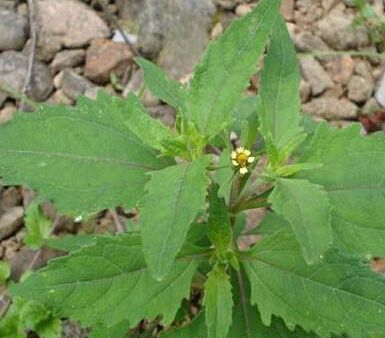Source: Whole plant of asteraceae, glandular stems, or lesser hairs. Are wild.
Cockroaches: annual herb, stem up to one meter, the upper part of the branch often double complex, densely covered pubescent. Leaves opposite, papery, triangular-ovate, margin irregularly lobed or coarsely toothed, pilose on both sides, palmately veined and reticulate veins prominent, upper leaves becoming smaller. Most flower heads are arranged on the branching end of the panicles with leaves, pedicels 2 to 4 cm in length, densely pubescent; stalks broadly campanulate, sepals secondary, abaxially densely pilose. Female flower corolla tongue, bisexual flower corolla tubular. Achene obovate, with four edges.
Adenosquama: Distinguish from the iliac crest: The stem is more branched, with longitudinal ribs, purple-brown, pubescent and hirsute hairs. Leaves opposite, ovate, base broadly cuneate, winged into petiole wings, cuspidate coarse teeth distally, upper leaves gradually reduced to lanceolate, capitate inflorescences, longer pedicels, densely glandular hairs.
Less hairy pods: The stems are thin and weak, with no glandular hairs, and the leaves are oval in shape with regular serrations on the edges.
Origin: across the country.

Vitamins are a type of trace organic substances that humans and animals must obtain from food in order to maintain normal physiological functions. In terms of physiological functions, vitamins are neither a raw material for tissues nor a substance for supplying energy, but they are an indispensable substance for the body. It has many types and different chemical structures. Most of them are the components of the coenzyme (or prosthetic group) of certain enzymes. They are the indispensable compounds for maintaining the normal growth (growth, health, reproduction and production function) of the body. It plays a catalytic role in the body to promote the synthesis and degradation of major nutrients (proteins, fats, carbohydrates, etc.), thereby controlling metabolism. Vitamins are essentially low-molecular organic compounds. They cannot be synthesized in the body, or the amount synthesized is difficult to meet the needs of the body, so they must be supplied from the outside. The daily requirement of vitamins is very small (usually measured in milligrams or micrograms). They are neither a raw material for body tissues nor a substance for energy supply in the body. However, they do not regulate material metabolism, promote growth and development, and maintain physiological functions.
Vitamin K2 MK-7, Vitamin C, Vitamin E, Vitamin K2, Vitamin H, Vitamin D3
Xi'an Gawen Biotechnology Co., Ltd , https://www.ahualynbio.com